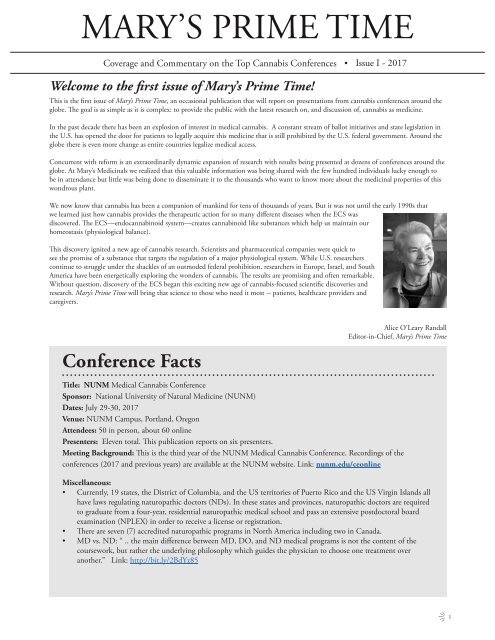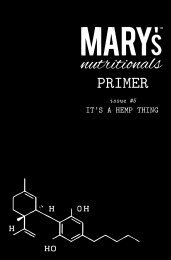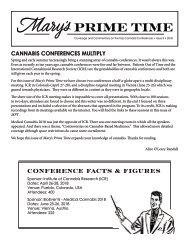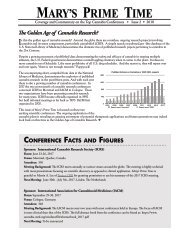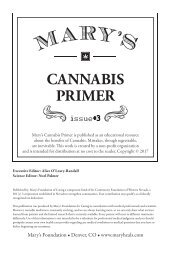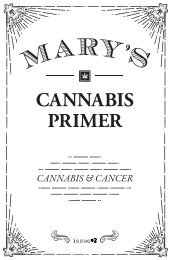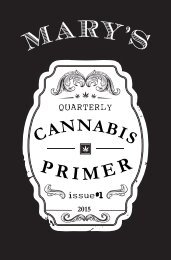Mary's Prime Time Issue 1
Coverage and commentary on the top cannabis conferences
Coverage and commentary on the top cannabis conferences
Create successful ePaper yourself
Turn your PDF publications into a flip-book with our unique Google optimized e-Paper software.
Coverage and Commentary on the Top Cannabis Conferences<br />
Welcome to the first issue of Mary’s <strong>Prime</strong> <strong>Time</strong>!<br />
This is the first issue of Mary’s <strong>Prime</strong> <strong>Time</strong>, an occasional publication that will report on presentations from cannabis conferences around the<br />
globe. The goal is as simple as it is complex: to provide the public with the latest research on, and discussion of, cannabis as medicine.<br />
In the past decade there has been an explosion of interest in medical cannabis. A constant stream of ballot initiatives and state legislation in<br />
the U.S. has opened the door for patients to legally acquire this medicine that is still prohibited by the U.S. federal government. Around the<br />
globe there is even more change as entire countries legalize medical access.<br />
Concurrent with reform is an extraordinarily dynamic expansion of research with results being presented at dozens of conferences around the<br />
globe. At Mary’s Medicinals we realized that this valuable information was being shared with the few hundred individuals lucky enough to<br />
be in attendance but little was being done to disseminate it to the thousands who want to know more about the medicinal properties of this<br />
wondrous plant.<br />
We now know that cannabis has been a companion of mankind for tens of thousands of years. But it was not until the early 1990s that<br />
we learned just how cannabis provides the therapeutic action for so many different diseases when the ECS was<br />
discovered. The ECS—endocannabinoid system—creates cannabinoid like substances which help us maintain our<br />
homeostasis (physiological balance).<br />
This discovery ignited a new age of cannabis research. Scientists and pharmaceutical companies were quick to<br />
see the promise of a substance that targets the regulation of a major physiological system. While U.S. researchers<br />
continue to struggle under the shackles of an outmoded federal prohibition, researchers in Europe, Israel, and South<br />
America have been energetically exploring the wonders of cannabis. The results are promising and often remarkable.<br />
Without question, discovery of the ECS began this exciting new age of cannabis-focused scientific discoveries and<br />
research. Mary’s <strong>Prime</strong> <strong>Time</strong> will bring that science to those who need it most -- patients, healthcare providers and<br />
caregivers.<br />
Conference Facts<br />
Alice O’Leary Randall<br />
Editor-in-Chief, Mary’s <strong>Prime</strong> <strong>Time</strong><br />
Title: NUNM Medical Cannabis Conference<br />
Sponsor: National University of Natural Medicine (NUNM)<br />
Dates: July 29-30, 2017<br />
Venue: NUNM Campus, Portland, Oregon<br />
Attendees: 50 in person, about 60 online<br />
Presenters: Eleven total. This publication reports on six presenters.<br />
Meeting Background: This is the third year of the NUNM Medical Cannabis Conference. Recordings of the<br />
conferences (2017 and previous years) are available at the NUNM website. Link: nunm.edu/ceonline<br />
Miscellaneous:<br />
• Currently, 19 states, the District of Columbia, and the US territories of Puerto Rico and the US Virgin Islands all<br />
have laws regulating naturopathic doctors (NDs). In these states and provinces, naturopathic doctors are required<br />
to graduate from a four-year, residential naturopathic medical school and pass an extensive postdoctoral board<br />
examination (NPLEX) in order to receive a license or registration.<br />
• There are seven (7) accredited naturopathic programs in North America including two in Canada.<br />
• MD vs. ND: “ .. the main difference between MD, DO, and ND medical programs is not the content of the<br />
coursework, but rather the underlying philosophy which guides the physician to choose one treatment over<br />
another.” Link: http://bit.ly/2BdYz85<br />
1
What is Naturopathy?<br />
The concept of naturopathy – the use of natural substances to promote<br />
healing and well being – is probably as old as mankind but according<br />
to Wikipedia, the term “naturopathy” wasn’t coined until 1895 and<br />
was first used extensively by Benedict Lust, a German who brought the<br />
concept to the U.S. in the early 1900s. The practice became somewhat<br />
controversial in the mid-1900s as Western pharmaceuticals reached<br />
a zenith in terms of development and promotion, crowding out “the<br />
old ways.” By the end of the 20th century, however, consumers (i.e.,<br />
patients) were revisiting naturopathic medicine and the practice saw a<br />
resurgence of interest that continues today.<br />
There are seventeen states that recognize naturopathy and numerous<br />
schools that teach naturopathic physicians. This includes the<br />
National University of Naturopathic Medicine (NUMN) in Portland,<br />
Oregon. In late July, NUNM presented its third “Medical Cannabis<br />
Conference” sponsored by the continuing education department at<br />
NUNM.<br />
What follows are reports on six of the eleven presentations at the<br />
conference. All reports on the NUNM conference are written by<br />
Mary’s <strong>Prime</strong> <strong>Time</strong> editor-in-chief, Alice O’Leary Randall. Those<br />
interested in reviewing the proceedings can access the tapes via www.<br />
nunm.edu/ce.<br />
According to the American Association of Naturopathic Physicians:<br />
“Naturopathic medicine is a distinct primary health care<br />
profession, emphasizing prevention, treatment, and optimal<br />
health through the use of therapeutic methods and substances that<br />
encourage individuals’ inherent self-healing process. The practice<br />
of naturopathic medicine includes modern and traditional,<br />
scientific, and empirical methods.”<br />
The merging of naturopaths and medical cannabis seems, well, a<br />
natural fit. Cannabis is often described as an herb and naturopaths use<br />
many herbs in their regimens. But the decades of false information<br />
and the ongoing U.S. federal prohibition of cannabis had the same<br />
chilling effect on many naturopaths as it has on medical professionals.<br />
Some naturopaths have embraced cannabis, especially its component<br />
cannabidiol (CBD). But other naturopathic doctors (NDs) still<br />
shy away from the substance with worries of addiction and, more<br />
realistically, concerns that the therapeutic abilities of cannabis may be<br />
overblown and lead patients down the wrong pathway, especially in<br />
the treatment of major illnesses such as cancer.<br />
Mary’s <strong>Prime</strong> <strong>Time</strong><br />
Published peridiocally by<br />
Mary’s Medicinals<br />
Editor-in-Chief: Alice O’Leary Randall<br />
alice@marysmedicinals.com<br />
Special Assistant: Jesica Clark<br />
Design: Luminary Digital<br />
Published by Mary’s Medicinals, Denver, CO<br />
Copyright (c) 2017 - All rights reserved<br />
MarysMedicinals.com<br />
This publication is solely for educational purposes and is not<br />
intended to substitute for the medical advice of a treating physician.<br />
Medicine and cannabis research is an ever-changing science.<br />
Therefore, the editor, contributors and publisher do not accept<br />
responsibility in the event of negative consequences incurred as a<br />
result of the information presented in Mary’s <strong>Prime</strong> <strong>Time</strong>. We do not<br />
claim this information is necessarily accurate by rigid scientific and<br />
regulatory standards applied for medical treatment. No warranty,<br />
expressed or implied, is furnished with respect to the material<br />
contained in this publication. Readers are encouraged to consult<br />
with personal physicians with respect to treatment of any medical<br />
condition.<br />
Cannabis in the Therapeutic Order<br />
Presenter: Paul Bergner, ND<br />
Director, North American Institute of<br />
Medical Herbalism<br />
The goal in attending the NUNM Conference was to learn how (or<br />
if) naturopathic doctors are integrating medical cannabis into their<br />
practice. With eleven speakers on the agenda (six are featured in<br />
this issue of Mary’s <strong>Prime</strong> <strong>Time</strong>) it seemed a relatively wide range of<br />
viewpoints would be presented but the first speaker made this writer’s<br />
heart sink.<br />
Paul Bergner is director of the North American Institute of Medical<br />
Herbalism and editor of the Medical Herbalism Journal. A search of<br />
the web after the conference revealed that Dr. Bergner has frequently<br />
spoken on the adverse effects of cannabis and even though he issued<br />
an opening disclaimer that he was speaking neither “for nor against”<br />
medical cannabis his presentation had a distinct lean towards the<br />
latter.<br />
He began by explaining the Therapeutic Order, a concept that is not<br />
necessarily new but has been re-packaged for the modern era by Drs.<br />
Jared Zeff and Pamela Snider.<br />
The Therapeutic Order emphasizes the classical regimen of the<br />
ancients with focus on diet, exercise, rest, and emotions. Under<br />
this scenario, herbal treatments are rather high on the chart. As Dr.<br />
2
how Dr, Bergner treats cannabis dependent patients at his clinic. He<br />
stated it was important to understand heavy cannabis users, which<br />
he loosely described as using “multiple times a day,” as they become<br />
“dependent” on the drug. He also stated that he believes “medical<br />
cannabis users become heavy users.”<br />
Bergner noted, the ancient Chinese felt that “once you resort to<br />
needles and herbs you have already failed.”<br />
But, as Dr. Bergner acknowledged, most naturopathic practitioners are<br />
likely to use herbal remedies more readily than the Therapeutic Order<br />
would dictate. So the question in this writer’s mind was, “Why not<br />
cannabis?”<br />
According to Dr. Bergner the reason lies in the concentrated forms and<br />
high doses of cannabis that are needed. Besides, noted the herbalist, it<br />
is not curative for any condition.<br />
Micro-dosing cannabis apparently has not yet reached the proponents<br />
of Therapeutic Order nor did the effective treatment of symptoms get<br />
much respect from the opening speaker.<br />
Dr. Bergner’s “long term strategies” for medical cannabis use are as<br />
follows:<br />
• Cannabis used for harm reduction.<br />
• Cannabis used in place of, or to wean the patient off a more<br />
dangerous drug, or to reduce its dose.<br />
• Cannabis used to palliate while more substantial cure is put in<br />
place.<br />
My heart sank a little lower. While Bergner acknowledged that: 1)<br />
cannabis is far safer than most pharmaceutical medications, 2) may<br />
be good for those with terminal illness, 3) may help reduce the dose<br />
of opioids, and 4) has no lethal dose (“Let’s have a parade,” he rather<br />
cynically exclaimed), the speaker did nothing to elaborate on these<br />
possibilities. Instead the presentation took a strong right turn towards<br />
“Cannabis Adverse Effects” and for the next forty minutes we learned<br />
His final ten slides did deal directly with therapeutic cannabis use but<br />
even here the bias was obvious as he featured studies that, for the most<br />
part, used the synthetic dronabinol (Marinol), not cannabis.<br />
Dr. Bergner’s full presentation was two hours long and at the<br />
conclusion this writer made a notation, “Focus of talk really treatment<br />
of withdrawal.” While I had no idea what I would find at the<br />
naturopathic conference I expected more tolerance and curiosity.<br />
Only two hours into a two-day conference and I was feeling as if I had<br />
wasted my time and was about to hear the naturopathic version of<br />
“Just Say No.”<br />
Practical Uses of Cannabinoids in Clinical Practice<br />
Presenters: Chris D. Meletis, ND and Brian Martin, BSc, ND,<br />
EmerChanges Health and Happiness Clinic<br />
After such a dismal opening the next speaker, Chris Meletis, proved to<br />
be a bracing gust of fresh air. He immediately distanced himself from<br />
the first speaker saying, “Whereas Paul Bergner was speaking about<br />
the marijuana side of cannabis sativa I am speaking about the hemp<br />
side” and then proceeded to give a robust discussion of the cannabis<br />
component cannabidiol (CBD).<br />
He quickly ran through some informative slides providing information<br />
on the hemp industry and the “self-medicating” population of the<br />
U.S.A. His point was clear: Americans are self-medicating already with<br />
hemp and all manner of other medications. Should naturopaths be<br />
helping them do so effectively?<br />
Dr. Meleits did not come to coddle or hold hands. He expected a<br />
certain level of knowledge from the audience relative to CBD and the<br />
endogenous cannabinoid system (ECS) as well as a proper perception<br />
of the culture today which is, in Dr. Meletis’ view, suffering from a<br />
wide array of inflammatory diseases including depression which he<br />
feels is inflammation of the brain. CBD, he notes, is an excellent<br />
anti-inflammatory agent and there is “plenty of research” to back up<br />
this statement.<br />
Meletis feels that CBD is safe and should be used as a preventative.<br />
“Do you wait until a patient has it?” he asked the audience about an<br />
dementia patient, “Or do you start preventatively?” For Dr. Meletis<br />
the answer was obvious. He acknowledged that cannabinoid science<br />
3
is in its infancy but feels that it has a bright future.<br />
The former Dean of Naturopathic Medicine and Chief Medical<br />
Officer at the NUNM, Meletis feels that hemp derived CBD is a<br />
good option for starting patients on cannabinoid medicine because<br />
it lacks the psychoactive effect (the “high”) of regular cannabis. Can<br />
people get “high” on CBD? Meletis acknowledges that some patients<br />
claim to get high from CBD so he asks them to explain why they feel<br />
they are “high.” Meletis will tell them, “that’s not high, that’s alive.”<br />
The patients, he says, “didn’t know how broken they were” until after<br />
the CBD starts to work and their resulting sense of well-being is<br />
sometimes euphoric.<br />
Martin is clearly fascinated by CBD and stated “there is a huge<br />
amount of interplay” between the body and CBD. An area of<br />
particular interest for him is the role of CBD in controlling cortisol,<br />
a naturally produced steroid hormone. As the body faces stress it will<br />
produce increased amounts of cortisol which, in turn, can increase<br />
blood sugar, suppress the immune system as well as numerous other<br />
effects on the metabolism of humans. Using CBD to control cortisol<br />
results in a win-win situation for the patient.<br />
Meletis was keen on distinguishing between cannabis and hemp, or<br />
as his final slide noted “hemp is not marijuana.” This proved to be a<br />
common theme as the conference moved on through the weekend.<br />
The next speaker was Brian Martin, a naturopathic doctor from<br />
Canada. He continued the cannabidiol enthusiasm of Dr. Meletis<br />
but noted that CBD is not as readily available in Canada as it is in the<br />
U.S. This seemed a particularly odd statement given Canada’s liberal<br />
national stance with respect to medical cannabis.<br />
Unfortunately Martin was too rushed by time constraints to cover all<br />
of the topics that are contained in his slides. His presentation, and<br />
all the presenters, were taped by NUNM and those presentations are<br />
available online.<br />
Dr. Martin feels that CBD has a special place in the treatment<br />
of alcoholism. In a fascinating 2013 study published in Elsevier’s<br />
Pharmacology Biochemistry and Behavior (http://bit.ly/2AvoGvb) it<br />
was discovered that transdermal delivery of CBD lessened alcoholinduced<br />
neurodegeneration in rodents by almost 50%. It is obviously<br />
preliminary research but it demonstrates the potential value of CBD in<br />
medical treatment.<br />
Hand-in-hand with neurodegeneration in alcoholism is the damage<br />
that alcohol causes to the liver. Martin presented excerpts from a<br />
2016 article that appeared in Clinical Liver Disease: A Multimedia<br />
Review Journal entitled “Cannabinoids in liver diseases” (http://<br />
bit.ly/2i9AKKO) that contained some conflicting but nevertheless<br />
promising conclusions. And a study from 2017 demonstrated that<br />
CBD is almost as effective as interferon in treating hepatitis C.<br />
Dr. Martin concluded that “CBD is almost to good to be true.” He<br />
paused for a moment before adding, “if it was a drug I wouldn’t<br />
believe it.”<br />
The CBD Evidence Base & Understanding Terpenes<br />
Presenter: Kevin Spelman, PhD, CEO at Health Education and Research<br />
University of Exeter/University of North Carolina<br />
Kevin Spelman is a very entertaining speaker and that is probably why<br />
he was asked to give two presentations at the NUNM conference. On<br />
the first day Dr. Spelman spoke on “The CBD Evidence Base” and<br />
on the second he discussed “Cannabis Chemistry: Understanding<br />
Terpenes.” Not surprisingly there was some repetition but the purpose<br />
of these conferences is to educate and repetition is a remarkably<br />
effective educational tool. Additionally the two topics do blend nicely<br />
and so both talks will be covered in this report.<br />
Spelman unabashedly loves CBD but also feels that the current<br />
climate is a bit “over zealous” with respect to CBD in general because<br />
“people want to cash in.” He insists, however, that does not negate “the<br />
remarkable science” that is emerging with respect cannabis and CBD<br />
in particular.<br />
He began by dispelling some popular misinformation about CBD<br />
in particular the notion that CBD is non-psychotropic. CBD, says<br />
Spelman, is not “euphoric” but it is “psychotropic.”<br />
4
then re-infused, although there is some controversy about this process<br />
and whether it destroys the desired chemical activity. Terpenes give<br />
cannabis its distinctive odor. They do the same for pine trees, oranges,<br />
lemons and on and on. But the emerging science is showing that<br />
terpenes may influence the properties of cannabis in far more ways<br />
than the aroma. Those who embrace the concept of the entourage<br />
effect nod knowingly at this thought and say, “of course.”<br />
The terpene talk was highly technical and made the audience<br />
keenly aware of the complexities in the emerging field of medical<br />
cannabinoids. Dr. Spelman noted that research is showing terpenes<br />
and cannabinoids can effect even the tiniest of metabolic factors, SNPs<br />
(pronounced “Snips” — Single Nucleotide Polymorphisms) which are<br />
found in your DNA. One questioner at the end of the session pleaded<br />
with Dr. Spelman, “I need you to write a book!,” she said to laughter,<br />
“Because I can know some of these things but this is a lot! This is a<br />
whole specialization and I’m looking at general patients.”<br />
He also addressed the notion that CBD, when ingested, becomes<br />
THC due to the interaction with stomach acid. While it may be<br />
possible to do this in a test tube, Spelman says, in vivo the idea just<br />
makes “no sense” and cited an article by Grotenhemen and Russo that<br />
“lays to rest” this notion of molecular changes (see page 8).<br />
Dr. Spelman did provide an excellent overview of using CBD in about<br />
a half dozen conditions including inflammation, traumatic brain<br />
injury (TBI), epilepsy, memory, and chronic pain, noting that nearly<br />
all these conditions involve some form of inflammation and hence the<br />
value of CBD. The current problem, one noted by several speakers<br />
and questions from the audience, is dosing Spelman encouraged<br />
using CBD in “nudges.” “It’s all about dose,” he said and noted that<br />
effective doses can be as low as 0.01mg to 20 mg.<br />
Terpenes<br />
Spelman’s second presentation at the conference focused on terpenes<br />
which have taken on a nearly mystical fascination in recent years.<br />
Terpenes are any of a large group of volatile unsaturated hydrocarbons<br />
found in the essential oils of plants, especially conifers, citrus trees<br />
and cannabis.<br />
Cannabis has many different terpenes and the science is so<br />
sophisticated at this point that plants can be bred to possess certain<br />
terpenes. They can be removed from plants prior to processing and<br />
Spelman’s light hearted demeanor became very serious. And rightly<br />
so. This is a question that burdens naturopaths, physicians and nurses<br />
throughout the world. Spelman noted that cannabis is, after all, only<br />
a plant and that naturopaths already use other plants on which there<br />
there is far less data adding that at present “we are over-focused on<br />
cannabis.” He counseled the audience member to begin learning the<br />
cannabis plant just as she has learned about others and recognize that<br />
this is simply a part of being a naturopath--it is a lifetime of learning<br />
about plants. Spelman took one the mantras of cannabis opponents —<br />
“cannabis is a gateway drug” — and put a new twist on it. “Cannabis,”<br />
he said, “is a gateway plant for physicians to start taking medicinal<br />
plants seriously.” Cannabis, Spelman believes, has made medical<br />
doctors sit up and take notice of medicinal plants and, in Spelman’s<br />
estimation, this is a tremendous opportunity for naturopathy and<br />
Western medicine to come closer together.<br />
Cannabinoids for Inflammation and the Immune System<br />
Presenter: Sunil Pai, MD, House of Sanjevani Integrative Medicine Clinic<br />
Unlike the other presenters, Sunil Pai is an M.D., not an N.D. but his philosophy of treatment seems<br />
very in tune with the naturopaths. He is the author of An Inflammation Nation which examines the<br />
prevention and treatment of disease through diet, lifestyle and the use of natural anti-inflammatories.<br />
For Dr. Pai, cannabis, and in particular CBD, is a tailor-made agent for treatment of many inflammatory<br />
disorders.<br />
The operative statement is “tailor-made.” Numerous speakers at the NUNM Conference addressed<br />
the idea of tailoring cannabis to the patient but Dr. Pai is practicing what he preaches at his clinic<br />
in New Mexico. Not surprisingly given the title of his book, he also emphasized the need to treat<br />
inflammation which in medical parlance is an “-itis” as in arthritis, gastritis, rhinitis, etc. There are<br />
over 200 different forms of “itis” in medical books and conventional Western philosophy is to treat the<br />
symptoms as opposed to the cause. Dr. Pai feels that careful treatment of the ECS is one way to actually<br />
resolve inflammation problems and believes “ECS regulation is strongly influenced by the individual’s<br />
microbiome.”<br />
5
He emphasizes the need to treat “the moment” as well as the fact that it is “not as simple as on/off” when it comes to CB1 and CB2 receptors.<br />
Indeed, several speakers at the conference emphasized this latter point: that treating disease via the ECS system is not simply a matter of<br />
prescribing CBD and seeing the patient six months later. One of Dr. Pai’s slides put it well although not succinctly:<br />
This system is not a simple on/off receptor effect. [It is a] complex response mechanism … between the endogenous and exogenous [molecules],<br />
in cross-reactions with non-cannabinoid receptors, and in the plasticity of response, which is dependent on local tissue characteristics (state<br />
of health) or the presence of other molecules.<br />
“The most important thing of my lecture,” Dr. Pai said, “is that CB2 receptors act differently based on the state of pathology.” In fact, according<br />
to Dr. Pai, CB2 receptors are more active in diseased organs. Thus, again, the need for tailoring the treatment on a regular basis when treating<br />
the diseased state as well as microdosing. Too many clinicians err in thinking that a patient who responds well initially to CBD just needs more<br />
CBD. In fact, the opposite may be true because a constant dose of CBD may dull the receptors by interfering with upregulating. Once again,<br />
tailoring the treatment for the patient.<br />
Dr. Pai’s presentation is highly recommended and available for viewing at: https://cemoodle.nunm.edu/course/category.php?id=221<br />
Cannabis in Cancer Care<br />
Presenter: Neil McKinney, BSc, ND<br />
Vital Victoria Naturopathic Clinic<br />
Neil McKinney is a practicing naturopath from Canada who<br />
specializes in treating cancer patients. He has been a clinician for<br />
nearly forty years and his presentation was a delightful mix of<br />
pertinent information along with some homespun common sense.<br />
His comments in the first two minutes of the presentation set the<br />
stage for what was to come when he expressed his fascination with the<br />
ECS and declared how delighted he was to have natural cannabinoid<br />
products available for his patients because “it is part of our biological<br />
heritage, it’s part of our legal right to have this plant.”<br />
He quickly ran through the main cannabinoids — THC, CBD, CBC,<br />
CBN and CBG — making it clear that he is a great fan of aggressive<br />
research into the many cannabinoids but rather confidently predicted<br />
that CBG (cannabigerol) will “be the next big bomb.” He has used<br />
CBG together with CBD and THC to treat cancers with some success.<br />
One of the most informative sections of his talk had to do with<br />
concerns about using cannabis to treat children and he listed the<br />
reasons why.<br />
Dr. McKinney provided a comprehensive look at his philosophy<br />
relative to treating cancer patients with cannabis. He basically<br />
addressed two separate areas. First, he dispelled the concerns relative<br />
to using a natural medicine like cannabis with today’s sophisticated<br />
oncology medications. Acknowledging the number of clinicians in the<br />
audience he stated categorically,<br />
“There are very, very few interactions between natural medicines<br />
and oncology drugs. Period. End of story. Forty years of<br />
experience in the field and I tell you you really don’t have to<br />
sweat it that much.”<br />
Secondly, he addressed the use of cannabis, in particular pure THC<br />
oil, for treatment of cancer, cautioning the clinicians that the high<br />
doses required to make the THC effective can really create adverse<br />
effects in patients. He advocates administering citicoline or CBD<br />
prior to dosing with THC oil saying it will help mitigate the effects<br />
of THC. (Note: some practitioners feel citicoline can be harmful for<br />
cancer patients, especially those with brain tumors.)<br />
Dr. McKinney provided several case studies from his practice as well<br />
as those found in the literature. Space will not allow recounting these<br />
several cases. For those seeking specific information on this topic the<br />
complete talk with powerpoint slides is available at:<br />
http://www.nunm.edu/ceonline<br />
6
Cannabinoids and Opiates: Crosstalk and Connections with Regard to<br />
Reward, Addiction, Dependence and Recovery<br />
Presenter: Kevin Wilson, ND, DAAPM<br />
Kevin Wilson, ND had the unenviable position of final speaker at a<br />
two-day conference. The good doctor never acknowledged it but it<br />
seemed to this writer that he was exhibiting some of the same feelings<br />
as those in the audience. He seemed weary and a bit dazed by the<br />
wealth of information that had come before him. At one point he said<br />
that what he had learned that week-end was a little “overwhelming.”<br />
The room seemed to issue a collective thought of, “Amen!”<br />
Nevertheless Dr. Wilson had come to present on Cannabinoids and<br />
Opioids so he pressed on with his slides in an almost apologetic<br />
fashion. Claiming to be “pro cannabis” he noted that he was beginning<br />
to have “reservations because [cannabis] does lead to dependency”<br />
and later noting that perhaps “we need to put it back in perspective<br />
after this sort of post prohibition time.” Dr. Wilson spoke with the<br />
air of someone wanting to stop the hands of time. It was a peculiar<br />
presentation in that regard.<br />
As the talk proceeded it seemed apparent that what puzzled Dr.<br />
Wilson was what Dr. Pai had addressed in his talk: the complexity of<br />
the cannabis plant and the realization that cannabinoid receptors are<br />
far more complex than “on or off.” For Dr. Wilson, like Dr. Bergner<br />
on the first day, there was almost and annoyance that cannabis was<br />
proving so difficult to fathom.<br />
Award-Winning Transdermal Patch Patch<br />
He noted that in states that have legalized cannabis for medical<br />
purposes there is a drop in prescription pain medications and tipped<br />
his hat to the work of Ashley and W. David Bradford which has shown<br />
significant economic savings in those states.<br />
Dr. Wilson’s confusion is fueled, in part, by his compassion. He<br />
wants to help opioid addicts and those in pain. He views cannabis<br />
as a possible tool in that quest. His admitted a fascination with<br />
neural plasticity (“the love of my [academic] life”) and the vast<br />
complexity of the human brain. As a practitioner he seems frustrated,<br />
almost conflicted, with the unexpected complexity of cannabis,<br />
particularly with respect to dosing. This is a common problem, not<br />
just for naturopaths but also MDs who are recommending cannabis.<br />
Naturopaths, however, seem almost guilty about this internal conflict,<br />
perhaps because cannabis is a natural product.<br />
As Dr. Wilson made his way through his presentation he provided<br />
leads to some excellent research articles. Several of them are listed on<br />
page 8. He made his case for cannabis addiction (which should have<br />
been called THC addiction) by citing several studies (all animal based)<br />
and concluded that approximately 7% of cannabis users are estimated<br />
to become addicted. But then he added, “I’m beginning to realize that<br />
people can be addicted to all kinds of things.”<br />
The final third of his presentation gave attendees some ideas relative<br />
to treating withdrawal with a variety of available pharmaceuticals<br />
including clonidine, Immodium and even ketamine.<br />
It is ironic that the naturopathic conference on medical cannabis<br />
would begin and end with presentations so heavily weighted in the<br />
issue of alcohol and opioid addiction and treatment. Perhaps this<br />
investiture in the recovery community has made it particularly difficult<br />
for NDs to embrace medical cannabis. Certainly this conference<br />
revealed hints of that.<br />
The The Remedy Tincture<br />
• Quick • Quick onset onset & unsurpassed & unsurpassed duration duration<br />
• Discreet • Discreet & easy & to easy use to for use all for day all (or day night) (or night) relief relief<br />
• Adheres • Adheres simply simply to any to veinous any veinous part of part the of skin the skin<br />
www.MarysMedicinals.com<br />
• Mary’s best-selling sublingual tincture packed with 500mg of organic CBD<br />
• Has potential to provide an array of benefi ts including pain relief, antiinflammatory,<br />
anxiety reducer, antispasmodic and more<br />
• Intended for proactive daily cannabinoid therapy<br />
• One of the most concentrated and pure full-spectrum tinctures<br />
on the market<br />
www.MarysMedicinals.com<br />
7
Bibliographies<br />
The following references are from the presentations of several speakers at the National University of<br />
Naturopathic Medicine (NUNM) Medical Cannabis Conference. The citations are, for the most part,<br />
available online, particularly using Google Scholar.<br />
Dr. Kevin Spelman: CBD and Terpenes<br />
Cannabidiol Enhances the Inhibitory Effects of delta-9-Tetrahydrocannabinol<br />
Cannabidiol on Human Glioblastoma Enhances the Cell Inhibitory Proliferation Effects and of delta-9-Tetrahydrocannabinol<br />
Survival, Marcu, et al.,<br />
on Human Glioblastoma Cell Proliferation and Survival, Marcu, et al.,<br />
Even High Doses of Oral Cannabidol Do Not Cause THC-Like Effects in<br />
Molecular Cancer Therapy. 2010; 180-189. https://www.ncbi.nlm.nih.gov/<br />
Molecular Cancer Therapy. 2010; 180-189. https://www.ncbi.nlm.nih.gov/<br />
Humans: Comment on Merrick et al. F. Grotenhermen Franjo, Russo Ethan,<br />
pubmed/20053780<br />
pubmed/20053780<br />
and Zuardi Antonio Waldo. Cannabis and Cannabinoid Research. January 2017,<br />
2(1): 1-4. https://doi.org/10.1089/can.2016.0036<br />
The Path Ahead - What Should We Tell Our Patients about Marijuana<br />
The (Cannabis Path Ahead indica - and What Cannabis Should We sativa)? Tell Our Pizzorno, Patients Integrative about Marijuana Medicine. 2016;<br />
(Cannabis indica and Cannabis sativa)? Pizzorno, Integrative Medicine. 2016;<br />
Cannabidiol in Inflammatory Bowel Diseases: A Brief Overview. G. Esposito,<br />
15 (6): 8-12. https://www.ncbi.nlm.nih.gov/pubmed/28223891<br />
15 (6): 8-12. https://www.ncbi.nlm.nih.gov/pubmed/28223891<br />
et. al. Phytotherapy Research, May 2013, 27(5): 633-636. https://www.ncbi.<br />
nlm.nih.gov/pubmed/22815234<br />
Cannabis Extract Treatment for Terminal Acute Lymphoblastic Leukemia with<br />
Cannabis a Philadelphia Extract Chromosome Treatment for Mutation, Terminal Singh Acute & Lymphoblastic Bali, Case Reports Leukemia in Oncology with<br />
a Philadelphia Chromosome Mutation, Singh & Bali, Case Reports in Oncology<br />
Neuroprotective Antioxidants from Marijuana. A.J. Hampson, et. al., Annals<br />
2013; 6: 585-592. https://www.ncbi.nlm.nih.gov/pmc/articles/PMC3901602/<br />
2013; 6: 585-592. https://www.ncbi.nlm.nih.gov/pmc/articles/PMC3901602/<br />
of the New York Academy of Sciences, January 2000, Vol 899. https://www.ncbi.<br />
nlm.nih.gov/pubmed/10863546<br />
Dr. Kevin Wilson: Cannabis and<br />
Dr. Kevin Wilson: Cannabis and<br />
Perceived efficacy of cannabidiol-enriched cannabis extracts for treatment of Opioid Withdrawal<br />
pediatric epilepsy: A potential role for infantile spasms and Lennox–Gastaut<br />
Opioid Withdrawal<br />
syndrome. S.A. Hussain, et.al., Epilepsy & Behavior, June 2015. Vol 47, pos. Medical Cannabis Use Is Associated With Decreased Opiate Medication Use<br />
138-141. https://www.ncbi.nlm.nih.gov/pubmed/25935511<br />
Medical in a Retrospective Cannabis Cross-Sectional Use Is Associated Survey With of Decreased Patients With Opiate Chronic Medication Pain. Use K. F.<br />
in Boehnke, a Retrospective E. Litinas, Cross-Sectional and D.J. Clauw, Survey The of Journal Patients of Pain, With Volume Chronic 17, Pain. <strong>Issue</strong> K. 6, F.<br />
Handbook of Cannabis Therapeutics: From Bench to Bedside, E. Russo and F.<br />
Boehnke, June 2016, E. pages Litinas, 739-744. and D.J. https://www.ncbi.nlm.nih.gov/pubmed/27001005<br />
Clauw, The Journal of Pain, Volume 17, <strong>Issue</strong> 6,<br />
Grotenhermen, Routledge, 2006.<br />
June 2016, pages 739-744. https://www.ncbi.nlm.nih.gov/pubmed/27001005<br />
Substitution of medical cannabis for pharmaceutical agents for pain,<br />
Substitution anxiety, and sleep. of medical B.J. Piper, cannabis R.M. for DeKeuster, pharmaceutical M.L. agents Beals, for et.al. pain, Journal of<br />
anxiety, and sleep. B.J. Piper, R.M. DeKeuster, M.L. Beals, et.al. Journal of<br />
Dr. Neil McKinney: Cannabis In Cancer Care Psychopharmacology, Volume 31, <strong>Issue</strong> 5, April 4, 2017. http://bit.ly/2n3BPWb<br />
Psychopharmacology, Volume 31, <strong>Issue</strong> 5, April 4, 2017. http://bit.ly/2n3BPWb<br />
Integrating cannabis into clinical cancer care, Curr. Oncology. Abrams, D., Cannabis and intractable chronic pain: an explorative retrospective analysis of<br />
Cannabis and intractable chronic pain: an explorative retrospective analysis of<br />
2016 ; 23 (2): S8-S14. https://www.ncbi.nlm.nih.gov/pubmed/27022315 Italian cohort of 614 patients. G. Fanelli, et. al., Journal of Pain Research, 2017;<br />
Italian 10: pages cohort 1217-1224. of 614 patients. https://www.ncbi.nlm.nih.gov/pubmed/28579820<br />
G. Fanelli, et. al., Journal of Pain Research, 2017;<br />
10: pages 1217-1224. https://www.ncbi.nlm.nih.gov/pubmed/28579820<br />
Cannabis Use and Risk of Lung Cancer: A Case Control Study, European<br />
Respir. J., Aldington, Harwood, Cox, et al., 2008; 31 (2): 280-286. https:// Opioid withdrawal suppression efficacy of oral dronabinol in opioid<br />
Opioid withdrawal suppression efficacy of oral dronabinol in opioid<br />
www.ncbi.nlm.nih.gov/pubmed/18238947<br />
dependent humans. M.R. Lofwall et. al., Drug and Alcohol Dependence,<br />
dependent Volume 164, humans. July 2016, M.R. pages Lofwall 143-150. et. al., https://www.ncbi.nlm.nih.gov/<br />
Drug and Alcohol Dependence,<br />
Volume 164, July 2016, pages 143-150. https://www.ncbi.nlm.nih.gov/<br />
Delta-9-tetrahydrocannabinol may palliate altered chemosensory perception in pubmed/27234658<br />
pubmed/27234658<br />
cancer patients: results of a randomized, double-blind, placebo-controlled pilot<br />
trial, Annals of Oncology, Brisbois, de Kock, Watanabe, et al., 2011; 22 (9): Cannabinoid and opioid interactions: Implications for opiate dependence and<br />
Cannabinoid and opioid interactions: Implications for opiate dependence and<br />
2086-2093. https://www.ncbi.nlm.nih.gov/pubmed/21343383.<br />
withdrawal, J.L. Scavone, R.C. Sterling, E.J. Van Bockstaele. Neuroscience,<br />
withdrawal, Volume 248, J.L. September Scavone, 2013, R.C. Sterling, pages 637-65. E.J. Van https://www.ncbi.nlm.nih.gov/<br />
Bockstaele. Neuroscience,<br />
Volume 248, September 2013, pages 637-65. https://www.ncbi.nlm.nih.gov/<br />
Cannabinoids: A new hope for breast cancer therapy?, Cancer Treatment. pubmed/23624062<br />
pubmed/23624062<br />
Caffarel, Andradas, Pérez-Gómez, et al.,Rev. 2012; 38 (7): 911–918. https://<br />
www.ncbi.nlm.nih.gov/pubmed/22776349<br />
Patented Transdermal Gel Pen<br />
Cannabinoids induce apoptosis of pancreatic tumor cells via endoplasmic<br />
reticulum stress-related genes. Carracedo, Gironella, Lorente, et al.<br />
Cancer Research. 2006; 66: 6748–55. https://www.ncbi.nlm.nih.gov/<br />
pubmed/16818650.<br />
Medical marijuana: the conflict between scientific evidence and political<br />
ideology. Part two of two. Cohen, P.J. J Pain Palliat Care Pharmacotherapy.<br />
2009;23:120-140. https://www.ncbi.nlm.nih.gov/pubmed/19296351<br />
Comparison of the analgesic effects of dronabinol and smoked marijuana in<br />
daily marijuana smokers. Cooper, Comer & Haney. Neuropsychopharmacology.<br />
2013 Apr 22. https://www.ncbi.nlm.nih.gov/pubmed/23609132<br />
Marijuana Smoking in Patients With Leukemia, Khwaja; Yacoub, Cheema,<br />
et al., Cancer Control 2016; 23 (3):278-283. https://www.ncbi.nlm.nih.gov/<br />
pubmed/27556668<br />
Adverse Structural and Functional Effects of Marijuana on the Brain: Evidence<br />
Reviewed. Mandelbaum & de la Monte, Pediatric Neurology. 2017; 66: 12-20.<br />
https://www.ncbi.nlm.nih.gov/pubmed/27789118<br />
• Accurately dosed, personalized cannabinoid blend<br />
• Fast acting, high bioavailability, premium quality<br />
• Rapid pain relief<br />
www.MarysMedicinals.com<br />
8


